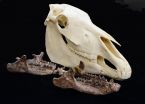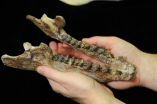Ancient rhino-relatives were water-loving
Large mammal bone discovery spurs identification of new species, genus
2014-10-08
(Press-News.org) The discovery of new bones from a large land mammal that lived about 48 million years ago has led scientists to identify a new branch of mammals closely related to modern horses, rhinos, and tapirs, according to a study published October 8, 2014 in the open-access journal PLOS ONE by Lisa Noelle Cooper from Northeast Ohio Medical University and colleagues.
This family of large mammals, Anthracobunidae, is only known from India and Pakistan and was commonly considered to be ancestors of modern elephants and sea cows. Geographically, this was a puzzling idea, because elephants and their relatives were groups that were known from Africa, not Asia. These new fossils indicate that anthracobunids are related to the tiny tapirs that are well known from the Pakistani rocks, and that perissodactyls probably originated in Asia.
Researchers also analyzed stable isotopes and bone shape, finding that these animals most likely fed on land and were large and lumbering, but spent a considerable amount of time near water, similar to modern rhinos and tapirs. Dr. Lisa Noelle Cooper added, "Anthracobunids are just one of many lineages of vertebrates that evolved from terrestrial animals, but then left to live in a shallow water habitat and had thick bones. These thick bones probably acted like ballast to counteract body buoyancy. You can see that kind of bone structure in modern hippos, otters, penguins, and cormorants."
Co-author Erik Seiffert added, "The evidence that has been accumulating from fossils and genes strongly suggests that the ancestor of elephants and sea cows lived in Africa, and at a time when that continent was totally isolated, so anthracobunids' Asian distribution was hard to explain."
INFORMATION:
In your coverage please use this URL to provide access to the freely available paper: http://dx.plos.org/10.1371/journal.pone.0109232
Citation: Cooper LN, Seiffert ER, Clementz M, Madar SI, Bajpai S, et al. (2014) Anthracobunids from the Middle Eocene of India and Pakistan Are Stem Perissodactyls. PLoS ONE 9(10): e109232. doi:10.1371/journal.pone.0109232
Funding: The National Science Foundation is acknowledged for support to M. T. C. (EAR-0847413), E. R. S. (BCS-0819186 and BCS-0416164), and J. G. M. T. (EAR-0207370). Also, S. B. acknowledges financial support received from the Department of Science and Technology, Government of India for field work in the Eocene sections of Gujarat. The funders had no role in the study design, data collection and analysis, decision to publish, or preparation of the manuscript.
Competing Interests: The authors have declared that no competing interests exist.
[Attachments] See images for this press release:


ELSE PRESS RELEASES FROM THIS DATE:
2014-10-08
Healthier foods and beverages have been consistently more expensive than unhealthier ones from 2002-2012, with a gap that's growing, according to a study published October 8, 2014 in the open-access journal PLOS ONE by Nicholas Jones from University of Cambridge, UK, and colleagues.
Governments have identified access to affordable healthy diets as a key factor in improving public health, yet methods for tracking prices of more and less healthy foods over time have not been established. The authors of this study analyzed existing government data on national food prices ...
2014-10-08
For the first time, robotic prostheses controlled via implanted neuromuscular interfaces have become a clinical reality. A novel osseointegrated (bone-anchored) implant system gives patients new opportunities in their daily life and professional activities.
In January 2013 a Swedish arm amputee was the first person in the world to receive a prosthesis with a direct connection to bone, nerves and muscles. An article about this achievement and its long-term stability will now be published in the Science Translational Medicine journal.
"Going beyond the lab to allow the ...
2014-10-08
CLEVELAND—Even before he lost his right hand to an industrial accident 4 years ago, Igor Spetic had family open his medicine bottles. Cotton balls give him goose bumps.
Now, blindfolded during an experiment, he feels his arm hairs rise when a researcher brushes the back of his prosthetic hand with a cotton ball.
Spetic, of course, can't feel the ball. But patterns of electric signals are sent by a computer into nerves in his arm and to his brain, which tells him different. "I knew immediately it was cotton," he said.
That's one of several types of sensation ...
2014-10-08
A new study, published today in the journal PLOS One, tracked the price of 94 key food and beverage items from 2002 to 2012. Its findings show that more healthy foods were consistently more expensive than less healthy foods, and have risen more sharply in price over time.
Food prices in the UK have risen faster than the price of other goods in recent years, and this new research shows that the increase has been greater for more healthy foods, making them progressively more expensive over time.
While less healthy foods had a slightly greater price rise relative to ...
2014-10-08
Berkeley — Fad diets come and go, but might there be something to the ones that involve consuming grapefruit and grapefruit juice? New research at the University of California, Berkeley, suggests that a closer look at grapefruit juice is warranted.
A new study, to be published Wednesday, Oct. 8, in the peer-reviewed journal PLOS ONE, found that mice fed a high-fat diet gained 18 percent less weight when they drank clarified, no-pulp grapefruit juice compared with a control group of mice that drank water. Juice-drinking mice also showed improved levels of glucose, ...
2014-10-08
Cut off by freeways and human development, mountain lions in southern California are facing a severe loss of genetic diversity, according to a new study led by the University of California, Davis in partnership with The Nature Conservancy.
The study, published today in the journal PLOS ONE, represents the largest genetic sampling of mountain lions, or pumas, in southern California. It raises concerns about the current status of mountain lions in the Santa Ana and Santa Monica mountains, as well as the longer-term outlook for mountain lions across southern California.
UC ...
2014-10-08
Plant scientists are working to improve important food crops such as rice, maize, and beans to meet the food needs of a growing world population. However, boosting crop output will require improving more than what can be seen of these plants above the ground. Root systems are essential to gathering water and nutrients, but understanding what's happening in these unseen parts of the plants has until now depended mostly on lab studies and subjective field measurements.
To address that need, researchers from the Georgia Institute of Technology and Penn State University have ...
2014-10-08
Lebanon, NH, 10/8/14 —To reduce false positives when identifying genetic variations associated with human disease through genome-wide association studies (GWAS), Dartmouth researchers have identified nine traits that are not dependent on P values to predict single nucleotide polymorphisms (SNP) reproducibility as reported in Human Genetics on October 2, 2014.
Reproducibility rates of SNPs based solely on P values is low. Dartmouth authors' analysis of GWAS studies published in Nature Genetics showed a 1-5 percent replication rate.
"It is important to improve our ...
2014-10-08
A new study from UCLA found that a drug being evaluated to treat an entirely different disorder helped slow the progression of Parkinson's disease in mice.
The study, published in the October edition of the journal Neurotherapeutics, found that the drug, AT2101, which has also been studied for Gaucher disease, improved motor function, stopped inflammation in the brain and reduced levels of alpha-synuclein, a protein critically involved in Parkinson's.
Although the exact cause of Parkinson's is unknown, evidence points to an accumulation of alpha-synuclein, which has ...
2014-10-08
Astronomers working with NASA's Nuclear Spectroscopic Telescope Array (NuSTAR), led by Caltech's Fiona Harrison, have found a pulsating dead star beaming with the energy of about 10 million suns. The object, previously thought to be a black hole because it is so powerful, is in fact a pulsar—the incredibly dense rotating remains of a star.
"This compact little stellar remnant is a real powerhouse. We've never seen anything quite like it," says Harrison, NuSTAR's principal investigator and the Benjamin M. Rosen Professor of Physics at Caltech. "We all thought an ...
LAST 30 PRESS RELEASES:
[Press-News.org] Ancient rhino-relatives were water-loving
Large mammal bone discovery spurs identification of new species, genus



